Diffusion MRI: Acquisition & Reconstruction
Diffusion MRI: Acquisition & Reconstruction
Oral
Oral
Diffusion
Wednesday, 15 May 2019
| Room 710B | 08:15 - 10:15 | Moderators: Muge Karaman, Allen Song |
08:15 |
0766. 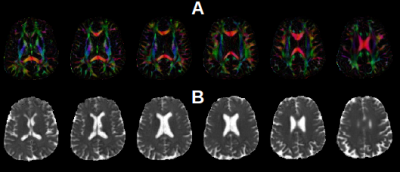 |
Diffusion MRI with b=1000 s/mm2 at TE < 22 ms using single-shot spiral readout and ultra-strong gradients: Implications for microstructure imaging
Lars Mueller, Suryanarayana Umesh Rudrapatna, Chantal Tax, Richard Wise, Derek Jones
The development of 300 mT/m gradients has opened new opportunities for exploring much shorter echo times (TE) in human diffusion imaging. Here, to further shorten TE, we developed a robust pulse-gradient spin-echo sequence with single-shot spiral readout on this hardware. The ultra-strong gradients induced vibrations, which were addressed by hardware modifications, while challenges posed by B0-inhomogeneity, eddy currents (captured using a field camera) and gradient-nonlinearity were addressed using iterative reconstructions. With this combination, for a b-value of 1000 s/mm2, we achieved TE = 21.7 ms. In this previously unchartered domain, we demonstrated enhanced sensitivity to myelin in spin-echo diffusion MRI.
|
08:27 |
0767 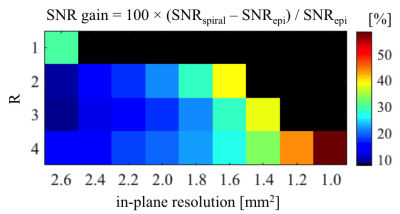 |
High-Resolution Diffusion MRI: In-Vivo Demonstration of the SNR Benefit of Single-Shot Spiral Acquisition vs. EPI Video Permission Withheld
Yoojin Lee, Bertram Wilm, Zoltan Nagy, Klaas Prüssmann
Spiral acquisition for diffusion-weighted imaging (DWI) has become possible with recent development of dynamic field monitoring and image reconstruction. In this work, we demonstrate high-quality in-vivo spiral DWI at high in-plane resolution (1mm) with minimal artifacts. In addition, we confirm the expected signal-to-noise ratio (SNR) gain of spiral- compared to echo-planar-imaging (EPI) readouts both theoretically and experimentally at varied resolutions and acceleration factors. An SNR gain up to 91% was measured in white matter. In conclusion, spiral acquisition provides improved SNR especially at high image resolutions.
|
08:39 |
0768. 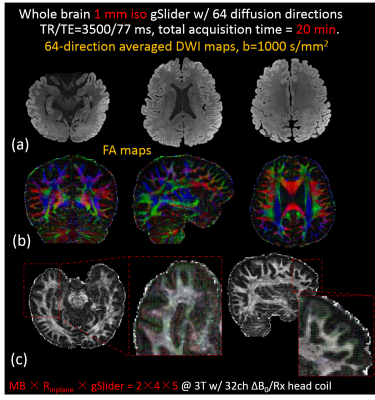 |
High-fidelity, high-isotropic resolution diffusion imaging through gSlider acquisition with B1+ & T1 corrections and multi-coil B0 shim array
Congyu Liao, Jason Stockmann, Qiyuan Tian, Berkin Bilgic, Mary Manhard, Lawrence Wald, Kawin Setsompop
gSlider is an SNR-efficient simultaneous multi-slab acquisition that has shown great potential for high-resolution diffusion imaging (DI). In this work, approaches to improve the fidelity of gSlider are proposed. A modified reconstruction which incorporates B1+ inhomogeneity and T1 recovery information was developed and demonstrated to successfully mitigate slab-boundary artifacts in short-TR gSlider acquisitions. Slice-by-slice B0-shimming through multi-coil shim-array, and high in-plane acceleration through virtual-coil GRAPPA were also incorporated into the acquisition and demonstrated to achieve 8-11x reduction in B0 distortion in single-shot EPI. The modified gSlider acquisition/reconstruction was used to acquire high-fidelity whole-brain 1mm isotropic DI with 64 diffusion-directions in 20-minutes at 3T.
|
| 08:51 |
0769. 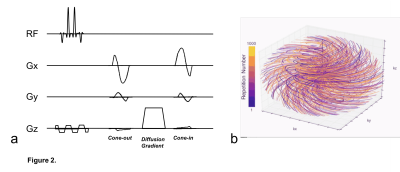 |
Double Echo Steady State (DESS) Cones for Motion-Robust Steady-State Diffusion-Weighted Imaging
Catherine Moran, Joseph Cheng, Christopher Sandino, Marcus Alley, Bruce Daniel, Michael Carl, Brian Hargreaves
Diffusion-Weighted Imaging (DWI) has shown potential for oncologic imaging without a contrast injection. However conventional methods are limited by low resolution and distortion. Steady-state DWI methods provide 3D, distortion-free images but are susceptible to motion artifacts. A Double Echo Steady State (DESS) method with a conical k-space trajectory is presented and assessed for motion artifact and diffusion-weighting with a focus on breast cancer imaging.
|
09:03 |
0770. 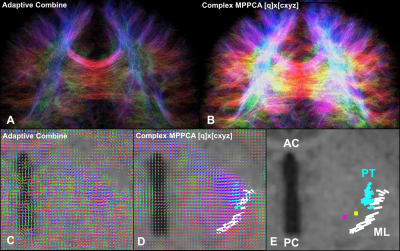 |
Achieving sub-mm clinical diffusion MRI resolution by removing noise during reconstruction using random matrix theory
Gregory Lemberskiy, Steven Baete, Jelle Veraart, Timothy Shepherd, Els Fieremans, Dmitry Novikov
We show how to achieve the benefits of inline-scan averaging for reducing thermal noise and lowering the Rician noise floor prior to image reconstruction, albeit in inequivalent diffusion MRI (dMRI) acquisitions. For that, we identify and remove the pure-noise principal components in joint coils x q-space x voxels dMRI data, as they follow the universal Marchenko-Pastur distribution. The method is demonstrated on 0.8mm isotropic voxels for b=1000 and 2000 protocol (3T), showing an increase of SNR and decrease of the Rician noise floor by 5-fold. We discuss applications in dMRI parameter estimation, tractography and functional neurosurgery.
|
| 09:15 |
0771. 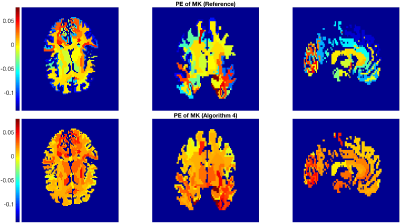 |
Cross-scanner and cross-protocol harmonisation of multi-shell diffusion MRI data: open challenge and evaluation results
Lipeng Ning, Elisenda Bonet-Carne, Francesco Grussu, Farshid Sepehrband, Enrico Kaden, Jelle Veraart, Stefano Blumberg, Can Son Khoo, Marco Palombo, Jaume Coll-Font, Benoit Scherrer, Simon Warfield, Suheyla Karayumak, Yogesh Rathi, Simon Koppers, Leon Weninger, Julia Ebert, Dorit Merhof, Daniel Moyer, Maximilian Pietsch, Daan Christiaens, Rui Teixeira, Jacques-Donald Tournier, Andrey Zhylka, Josien Pluim, Greg Parker, Umesh Rudrapatna, John Evans, Cyril Charron, Derek Jones, Chantal Tax
We present a comparison of twelve different methods that estimate mappings between scanners for multi-shell diffusion MRI data harmonisation. The methods are evaluated on a benchmark dataset acquired from 15 subjects using two scanners that both have a standard and a state-of-the-art protocol. The results show that cross-vendor harmonisation and spatial/angular resolution enhancement of multi-shell diffusion data sets can be performed reliably using suitable algorithms. The dataset is available upon request and can serve as a useful testbed for the development diffusion MRI harmonisation algorithms.
|
09:27 |
0772.  |
Toward high-SNR, motion-robust diffusion MRI of the liver using optimized gradient waveforms, non-gated free-breathing acquisitions, and motion-corrected averaging
Ruiqi Geng, Yuxin Zhang, Huiwen Luo, Diego Hernando
Liver DWI suffers from signal voids introduced by elastic motion, mis-registration due to respiratory motion and low SNR. We propose to develop and evaluate a novel free-breathing DWI technique appropriate for the abdomen, in order to provide high SNR efficiency with predictable scan times, while avoiding motion-related artifacts. Evaluations showed that compared to respiratory-triggering acquisitions, the proposed DWI technique provided higher SNR and predictable scan times. Further, a motion-corrected averaging algorithm has the potential to correct for motion-related artifacts. Using optimized gradient waveforms, non-gated free-breathing acquisitions, and motion-corrected averaging techniques, high-SNR and motion-robust DWI of the liver may be achieved.
|
| 09:39 |
0773. 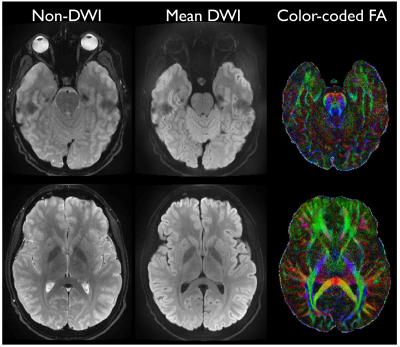 |
An efficient reconstruction by combining tilted-CAIPI with eddy-current calibration for high-resolution distortion-free diffusion imaging using DIADEM
Myung-Ho In, Zijing Dong, Kawin Setsompop, Daehun Kang, Uten Yarach, Yunhong Shu, Joshua Trzasko, John Huston, Matt Bernstein
As a variant of multi-shot echo-planar imaging, DIADEM (Distortion-free Imaging: A Double Encoding Method) enables high-resolution distortion-free imaging, but the prolonged scan time can be a major challenge. Recently, a novel parallel imaging approach, termed tilted-CAIPI, was suggested to unfold highly accelerated DIADEM data and to substantially reduce the acquisition time. However, the reconstructed image still suffers from eddy-current-induced geometric distortions in diffusion-weighted data. In this work, it is demonstrated that the DIADEM reconstruction becomes more efficient and practical after combining the tilted-CAIPI with the eddy-current calibration approaches.
|
09:51 |
0774. 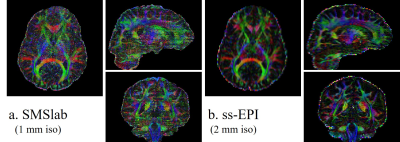 |
High-Resolution Isotropic Diffusion MRI Using Simultaneous Multi-slab (SMSlab) Acquisition
Erpeng Dai, Yuhsuan Wu, Hua Guo
3D multi-slab acquisition is an important technique for high-resolution isotropic diffusion MRI. To further accelerate the acquisition, simultaneous multi-slice (SMS) excitation can be combined with multi-slab, termed simultaneous multi-slab (SMSlab). Previously it has been demonstrated that the SMSlab un-folding problem can be solved using a 3D Fourier encoding framework. When applying SMSlab to diffusion MRI, the main challenge is how to simultaneously un-fold the excited multiple slices/slabs and correct the inter-shot phase variations. To achieve this, a delicate navigator acquisition is designed and a POCS-enhanced k-space phase correction method is used in this study.
|
| 10:03 |
0775. 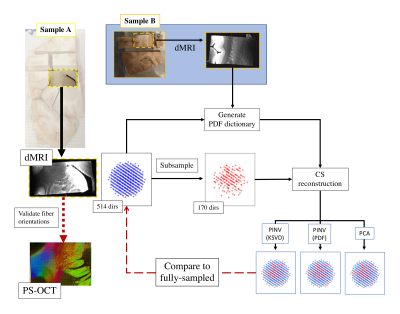 |
Validation of DSI compressed sensing reconstruction in ex vivo human brain
Robert Jones, Giorgia Grisot, Jean Augustinack, David Boas, Bruce Fischl, Hui Wang, Berkin Bilgic, Anastasia Yendiki
Compressed sensing algorithms for accelerating DSI acquisitions (DSI-CS) have helped bring DSI into the realm of clinical feasibility. Here, we assess the efficacy of dictionary-based CS methods in reconstructing high resolution ex vivo DSI of human brain blocks, and provide validation of ex vivo DSI-CS with ground truth optical imaging. We find that reconstruction accuracy, computation time and inter-subject dictionary generalizability are comparable to in vivo results, and that SNR appears influential in determining the limit of attainable reconstruction quality. We also show that fiber orientation estimates of reconstructed data are as accurate as fully-sampled estimates at a microscopic level.
|
 Back to Program-at-a-Glance |
Back to Program-at-a-Glance |  Back to Top
Back to Top